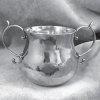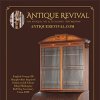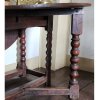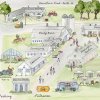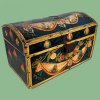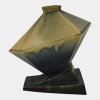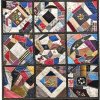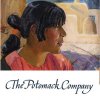It’s a Bidding “Three-for-All”
June 3rd, 2018
Thomaston Place Auction Galleries, Thomaston, Maine
Thomaston Place Auction Galleries is expanding its regular schedule of four major auctions per year from two days apiece to three. One session will present Maine artists, both past and present. The rest of the added days will be focused on collections. As the company’s vice president John Bottero explained, “Friday will be collections day.... It will be a large amount of cohesive things that if we put in the mix with the other things would get overwhelmed.... So it’s a smaller crowd, it’s more Internet bidding...but we’ll run our Friday sales from now on, on collections.” In the June 1-3 offering, the first day presented extensive collections of pre-Columbian pottery, African art, and Orientalia.

The priciest item of the sale was one of the smallest, a diamond solitaire lady’s ring, with one ideal-cut brilliant 6.24-carat diamond, described as of “L color and VVS1 clarity.” In a four-prong platinum setting, with full GIA documents, it sold for $58,500. Thomaston Place photo.

A large bronze standing leopard from Benin, possibly as early as the 19th century, stands tall at 19". It sold for $6435 with a $2000/3000 estimate. Thomaston Place photo.

The kick-off lot of the three-day sale was this pre-contact Hawaiian calabash poi bowl, known as an umeke, in kou wood, supposedly used only by Maui Ali’i chiefs. The butterfly repairs are called poho and huini, and the price was $2691.

Hawaiian lei niho palaoa, a royal necklace decoration, $4914. Thomaston Place photo.

A 36-star flag, in an unofficial six by six pattern, in use from 1864 to 1867. Nevada was the 36th state to be admitted to the Union in 1864, and Nebraska the 37th in 1867. The flag was consigned by descendants of Hannibal Hamlin (1809-1891) and his son Cyrus Hamlin (1839-1867). Hannibal was the first Republican to hold the office of vice president and served under Abraham Lincoln from 1861 to 1865. Cyrus served as a general in the Civil War, and he died shortly thereafter of yellow fever. The historical flag suffered from some possible battle damage, but it flew for $5850. Thomaston Place photo.
The second item on the block was the first to trash the estimate and keep on going. It was a rare Hawaiian ivory hook from a royal necklace known as a lei niho palaoa, a neck ornament carved from a sperm whale tooth. Traditionally it was worn suspended from the neck of royal or otherwise exalted persons by long strands of plaited human hair. There are various theories relating to the symbolism of the hook. It may represent a stylized tongue or the physical manifestation of a supernatural power. Estimated at $800/1200, it jumped all the way to $4914 (including buyer’s premium). Thomaston researcher David Fletcher noted, “The bigger the bolster of hair around your neck, the more support you had, and the more power you had politically.”
The full and correct title of the satirical novel popularly remembered as Gulliver’s Travels, first published in 1726, was Travels into Several Remote Nations of the World. In Four Parts. By Lemuel Gulliver, First a Surgeon, and then a Captain of several Ships, as presented on the title page. True author Jonathan Swift (1667-1745) once claimed that he wrote the book “to vex the world, not to divert it.” All four parts were contained in two volumes, offered as issued, with maps of the fictitious lands visited by the traveler, and in the original tooled calf leather binding. All told, it brought a Brobdingnagian $18,720.

First edition of the novel popularly known as Gulliver’s Travels, $18,720. Thomaston Place photo.

An unknown Outsider artist gave full vent to his artistic expression with this folk art carved and painted stepback cupboard, with a well-groomed but decidedly naked Adam and Eve contemplating the serpent’s offer of a worm-filled apple. The carvings are done in full relief, and some are three-dimensional. The lower doors are covered in seaweed fronds and underwater scenes. Its price of $1287 looked reasonable for such an unusual cupboard.

A pair of enormous gilded and patinated bronze 12-arm figural candelabra, modeled after sculptures created by Claude Michel Clodion (1738-1814). The individual satyr and bacchante figures stand under a trumpet-like cornucopia from which sprout the candle sockets adorned with grapes and other fruits. Fitted for electricity and with a $7000/9000 estimate, they lit up bidders to the tune of $24,570. Thomaston Place photo.
The Sutro Baths was an enormous, privately owned public saltwater swimming pool, built in 1896 in western San Francisco, California. It was built by Adolph Sutro (1830-1898), a wealthy engineer and philanthropist and the city’s 24th mayor. At the time of construction, it was the largest indoor pool in the world. Parts of the complex were fed directly by Pacific Ocean water. In addition, the gargantuan facility included an amphitheater, a museum, private dressing rooms, and several restaurants. The well-heeled Adolph Sutro never saw much profit from his project, as he died about two years after it opened. It was memorialized in a 12-sheet chromolithograph broadside, printed in the year of the opening and showing the cavernous swimming areas, that sold for $8775.
 auction catalog, despite carrying a modest $2000/3000 estimate. But bidders thought more highly of it than did the catalogers, chasing it all the way to a bronze-worthy $23,400.
auction catalog, despite carrying a modest $2000/3000 estimate. But bidders thought more highly of it than did the catalogers, chasing it all the way to a bronze-worthy $23,400.
For more information, visit the website (www.thomastonauction.com) or call (207) 354-8141.

Very heavy 17th-century English trestle table in solid elm, with a well-worn rounded single-plank top and a through-mortised base. The round ends were probably added about a century after its birth. With the expected wear and worm holes, it sold for $5557.50. Thomaston Place photo.

Seventeenth-century European walnut cassone, probably Italian, with deeply carved bas-relief scrolling floral panels, a two-board molded top, a semi-concealed drawer in the base, and original cotter pin hinges and hand-forged locking mechanism, all for $1287.

Here’s another item from the Orientalia section that made the estimate look pretty anemic. It’s a Meiji period moss-green Japanese jadeite seated Buddha, on a rosewood lotus-form plinth, in the apan mudra pose, a two-handed gesture that detoxifies and balances the body. The $1000/15000 estimate was a distant memory when the figure sold for $24,570. Thomaston Place photo.

Japanese ink on silk drawing of Confucius meeting Lao Tzu in a garden. It is signed and sealed on the left edge, possibly by Kano Toshun Yoshinobu (1747-1797). But even with the disclaimer of “possibly,” some knowledgeable bidders were confident enough to ignore the negligible $600/800 estimate, and they chased it all the way to $8775. Thomaston Place photo.

Unsigned life-size bronze garden sculpture of a young girl carrying a basin, $23,400.

This approximately 6' high 12-sheet chromolithograph advertising the Sutro Baths of San Francisco sold for $8775. Thomaston Place photo.
Originally published in the September 2018 issue of Maine Antique Digest. © 2018 Maine Antique Digest


